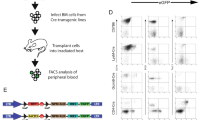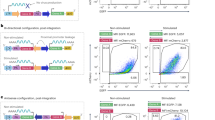Abstract
The development of chronic myelogenous leukemia (CML) models in mice using an inducible BCR-ABL gene has been hampered by the requirement of sequential expression of tTA (Tet repressor-VP16 fusion protein) and Tet-OP sequences in the same cells after separate transfection. This double transfection strategy is time consuming as it requires screening of many hundreds of individual clones and cannot be applied to primary hematopoietic cells. To generate a tetracycline-inducible BCR-ABL retrovirus, we have subcloned BCR-ABL p210 cDNA in the SIN-Retro-TET vector, which allows regulated expression of a gene of interest in a single autoregulatory cassette, containing both tTA and Tet OP sequences. Retroviral particles were obtained by transfecting the SIN-BCR-ABL p210 construct into the 293 cells and by VSVG pseudotyping. To determine the functionality of the retrovirus, the IL-3-dependent murine Ba/F3 cell line was retrovirally transduced and clones were grown in the absence of both IL-3 (to select for transformed cells) and a tetracycline analog, doxycycline (to induce BCR-ABL expression). Using this technique, polyclonal Ba/F3 cells and several growth factor-independent Ba/F3 clones expressing BCR-ABL were obtained within 2–3 weeks. A single dose of doxycycline added to the medium (1 μg/ml), induced in different clones, a reduction of BCR-ABL protein levels by 60–90% at 24 h, leading to cell death in the absence of IL-3. In several individual clones, BCR-ABL expression was further reduced to become almost undetectable at 48 h. The doxycycline-regulated BCR-ABL expression was stable, as many clones maintained in culture for >8 months showed a persistent inhibitory response to doxycycline addition in the medium. In in vivo experiments, subcutaneous injection of 2 × 106 Ba/F3-SIN p210 cells in nude mice induced visible tumors in 2 weeks and all established tumors completely regressed upon addition of doxycycline in the drinking water (200 μg/ml). To determine the functionality of the inducible BCR-ABL retrovirus in vivo, primary Lin− bone marrow cells were transduced with SIN-p210 and transplanted in lethally irradiated mice. All transplanted mice had successful hematopoietic reconstitution and BCR-ABL integration was found in the peripheral blood of seven out of 14 mice available for long-term analysis (>6 months). However, despite evidence of retrovirus-mediated gene transfer, there was no evidence of leukemia, due either to low viral titers or to the relative inefficiency of the minimal CMV promoter in primary hematopoietic cells. Thus, these results demonstrate for the first time, to our knowledge, the feasibility to generate an inducible BCR-ABL retrovirus in a single step, in the context of an immortalized cell line. Our data suggest that with further improvements of the retrovirus-mediated gene transfer technology, it might be possible to generate inducible leukemia models in mice by the use of single retroviral constructs.
This is a preview of subscription content, access via your institution
Access options
Subscribe to this journal
Receive 12 print issues and online access
$259.00 per year
only $21.58 per issue
Buy this article
- Purchase on Springer Link
- Instant access to full article PDF
Prices may be subject to local taxes which are calculated during checkout




Similar content being viewed by others
References
Sawyers CL . Chronic myeloid leukemia N Engl J Med 1999 340: 1330–1340
Clarkson BD, Strife A, Wisniewski D, Lambek C, Carpino N . New understanding of the pathogenesis of CML: a prototype of early neoplasia Leukemia 1997 11: 1404–1428
Daley GQ, Van Etten RA, Baltimore D . Induction of chronic myelogenous leukemia in mice by the P210bcr/abl gene of the Philadelphia chromosome Science 1990 247: 824–830
Pear WS, Miller JP, Xu L, Pui JC, Soffer B, Quackenbush RC, Pendergast AM, Bronson R, Aster JC, Scott ML, Baltimore D . Efficient and rapid induction of a chronic myelogenous leukemia-like myeloproliferative disease in mice receiving P210 bcr/abl-transduced bone marrow Blood 1998 92: 3780–3792
Zhang X, Ren R . Bcr-Abl efficiently induces a myeloproliferative disease and production of excess interleukin-3 and granulocyte–macrophage colony-stimulating factor in mice: a novel model for chronic myelogenous leukemia Blood 1998 92: 3829–3840
Gossen M, Bujard H . Tight control of gene expression in mammalian cells by tetracycline-responsive promoters Proc Natl Acad Sci USA 1992 89: 5547–5551
Gossen M, Freundlieb S, Bender G, Muller G, Hillen W, Bujard H . Transcriptional activation by tetracyclines in mammalian cells Science 1995 268: 1766–1769
Blau HM, Rossi FM . Tet B or not tet B: advances in tetracycline-inducible gene expression Proc Natl Acad Sci USA 1999 96: 797–799
No D, Yao TP, Evans RM . Ecdysone-inducible gene expression in mammalian cells and transgenic mice Proc Natl Acad Sci USA 1996 93: 3346–3351
Rivera VM, Clackson T, Natesan S, Pollock R, Amara JF, Keenan T, Magari SR, Phillips T, Courage NL, Cerasoli F Jr, Holt DA, Gilman M . A humanized system for pharmacologic control of gene expression Nat Med 1996 2: 1028–1032
Klucher KM, Lopez DV, Daley GQ . Secondary mutation maintains the transformed state in BaF3 cells with inducible BCR/ABL expression Blood 1998 91: 3927–3934
Hofmann A, Nolan GP, Blau HM . Rapid retroviral delivery of tetracycline-inducible genes in a single autoregulatory cassette Proc Natl Acad Sci USA 1996 93: 5185–5190
Ahmed M, Dusanter-Fourt I, Bernard M, Mayeux P, Hawley RG, Bennardo T, Novault S, Bonnet ML, Gisselbrecht S, Varet B, Turhan AG . BCR-ABL and constitutively active erythropoietin receptor (cEpoR) activate distinct mechanisms for growth factor-independence and inhibition of apoptosis in Ba/F3 cell line Oncogene 1998 16: 489–496
Ory DS, Neugeboren BA, Mulligan RC . A stable human-derived packaging cell line for production of high titer retrovirus/vesicular stomatitis virus G pseudotypes Proc Natl Acad Sci USA 1996 93: 11400–11406
Davis JL, Witt RM, Gross PR, Hokanson CA, Jungles S, Cohen LK, Danos O, Spratt SK . Retroviral particles produced from a stable human-derived packaging cell line transduce target cells with very high efficiencies Hum Gene Ther 1997 8: 1459–1467
Huettner CS, Zhang P, Van Etten RA, Tenen DG . Reversibility of acute B-cell leukaemia induced by BCR-ABL1 Nat Genet 2000 24: 57–60
Yu H, Eton D, Wang Y, Kumar S, Tang L, Terramani T, Benedict C, Hung G, Anderson W . High efficiency in vitro gene transfer into vascular tissues using a pseudotyped retroviral vector without pseudotransduction Gene Therapy 1999 6: 1876–1883
Galipeau J, Li H, Paquin A, Sicilia F, Karpati G, Nalbantoglu J . Vesicular stomatitis virus G pseudotyped retrovector mediates effective in vivo suicide gene delivery in experimental brain cancer Cancer Res 1999 59: 2384–2394
Gallardo HF, Tan C, Ory D, Sadelain M . Recombinant retroviruses pseudotyped with the vesicular stomatitis virus G glycoprotein mediate both stable gene transfer and pseudotransduction in human peripheral blood lymphocytes Blood 1997 90: 952–957
Acknowledgements
This work was supported by grants from the French Ministry of Research to AD and from the Association pour la Recherche contre le Cancer, Ligue Nationale contre le Cancer and Comite de Recherche Clinique of the Institut Gustave-Roussy to AGT. We also thank Dr HM Blau (Stanford University, CA, USA) for providing the retro-TET SIN vector.
Author information
Authors and Affiliations
Rights and permissions
About this article
Cite this article
Dugray, A., Geay, J., Foudi, A. et al. Rapid generation of a tetracycline-inducible BCR-ABL defective retrovirus using a single autoregulatory retroviral cassette. Leukemia 15, 1658–1662 (2001). https://doi.org/10.1038/sj.leu.2402225
Received:
Accepted:
Published:
Issue Date:
DOI: https://doi.org/10.1038/sj.leu.2402225
Keywords
This article is cited by
-
Chronic myeloid leukemia stem cells possess multiple unique features of resistance to BCR-ABL targeted therapies
Leukemia (2007)
-
Occurrence of de novo ABL kinase domain mutations in primary bone marrow cells after BCR-ABL gene transfer and Imatinib mesylate selection
Leukemia (2005)
-
Tight regulation from a single tet-off rAAV vector as demonstrated by flow cytometry and quantitative, real-time PCR
Gene Therapy (2004)
-
Membrane-bound Delta-4 Notch ligand reduces the proliferative activity of primitive human hematopoietic CD34+CD38low cells while maintaining their LTC-IC potential
Leukemia (2004)



